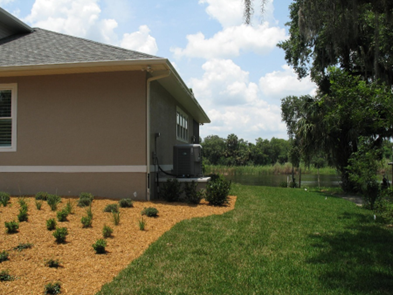Contact Information
Mitigation
What is mitigation?
Mitigation is the effort to reduce or eliminate the risks of injury and property damage from potential disaster events. These efforts can take the form of construction projects, education campaigns, alerting systems, policy updates, and more. Effective mitigation strengthens community resilience across all hazards.

Home Mitigation Grant Projects
Local governments can apply on behalf of homeowners for FEMA-funded hazard mitigation grants. Mitigation grants are reimbursement-based, typically funding 75% of eligible project costs (up to 90% or 100% in special cases).Grant cycles are competitive and subject to federal and state review timelines. Projects cannot begin until official approval is received.
To be considered for a future grant cycle, homeowners should submit:
- Proof of flood insurance
- Insurance claim documentation or flood loss photos
- Elevation quotes or appraisal documents
Submissions are reviewed by the Seminole County Resiliency Working Group.
Examples of Residential Mitigation Projects:
- Home elevation
- Voluntary buyout (acquisition and demolition)
- Installation of hurricane shutters or impact-resistant windows
- Roof reinforcement (hurricane straps/clips)
- Elevating HVAC units, water heaters, and electrical panels
For questions or to submit a project, contact:
em@seminolecountyfl.gov | 407-665-1012Seminole County Resiliency Working Group
The Seminole County Resiliency Working Group is a collaborative committee made up of representatives from all seven municipalities, county departments, state and federal agency partners, nonprofits, and engaged residents. The group meets regularly to identify hazards, assess risks, prioritize projects, and guide the County’s Local Mitigation and Resiliency Strategy (LMRS) and Floodplain Management Plan (FMP). Committee members bring diverse expertise in emergency management, planning, public works, environmental protection, and community outreach to help make Seminole County safer and more resilient to disasters.
The Seminole County Resiliency Working Group meets quarterly and holds interim meetings following major disasters. Meetings are open to the public. Dates are posted on the Seminole County Events Calendar
Know Your Flood Risk with Arkly
Want to understand your property’s flood risk? Arkly.com is a free, easy-to-use tool that lets you search any address in Seminole County to see flood hazard zones, past flood events, and other risk factors. It can help you make informed decisions about insurance, property improvements, and preparedness before the next storm.
Seminole County’s Mitigation Plans
Local Mitigation and Resiliency Strategy (LMRS)
In 1998, Seminole County received a federal grant through the State of Florida to develop a Local Mitigation Strategy (LMS) to reduce disaster recovery costs and long-term risks. This initiative became a federal requirement under the Disaster Mitigation Act of 2000 (44 CFR §§ 201 & 206), mandating that all local governments maintain an updated hazard mitigation plan.
Today, the LMS is known as the Local Mitigation and Resiliency Strategy for Seminole County. It is managed by the Seminole County Resiliency Working Group, which includes representatives from all seven municipalities, county departments, partner agencies, nonprofits, and engaged citizens.
The plan:
- Identifies hazards
- Assesses risk
- Sets mitigation goals and actions
- Prioritize projects that reduce community vulnerabilities
Floodplain Management Plan (FMP)
Seminole County’s Floodplain Management Plan is a comprehensive strategy to reduce flood risk, protect natural floodplain functions, and meet the requirements of the Federal Emergency Management Agency’s (FEMA) Community Rating System (CRS) Activity 510. The FMP is maintained by the Seminole County Floodplain Management Planning Committee, which includes county staff, municipal representatives, state and federal agency partners, and members of the public.
The plan:
- Identifies flood hazards and areas of highest risk
- Evaluates vulnerability of people, property, and critical facilities
- Establishes goals and action items to reduce flood impacts
- Integrates mitigation strategies into local policies, codes, and programs
- Supports CRS participation to lower National Flood Insurance Program (NFIP) premiums for residents
Community Benefit: meeting and exceeding FEMA’s CRS standards, the FMP helps qualify Seminole County residents for flood insurance premium discounts of up to 20%, while also promoting long-term flood resilience across the community.
Community Wildfire Protection Plan (CWPP)
Seminole County’s Community Wildfire Protection Plan outlines strategies to reduce wildfire risk, protect life and property, and enhance forest health in coordination with the Florida Forest Service and local fire departments. The CWPP is developed and maintained with input from county staff, municipal partners, fire and forestry officials, and community stakeholders.
The plan:
- Identifies areas of high wildfire hazard within the county
- Assesses vulnerabilities for homes, infrastructure, and natural resources
- Establishes fuel management, defensible space, and community preparedness strategies
- Coordinates with land management agencies for controlled burns and vegetation management
- Supports public education and outreach to reduce wildfire ignition risks
Community Benefit: The CWPP strengthens eligibility for state and federal wildfire mitigation grants, improves response coordination, and reduces insurance risk ratings for properties in wildfire-prone areas.
Mitigation Planning Resources
To request any of the following plans or submit a mitigation project before or after Resiliency Working Group meetings, contact the Office of Emergency Management at em@seminolecountyfl.gov
Plans Available:
- 2025-2030 Draft Floodplain Management Plan for Public Comment
- 2025–2030 Local Mitigation and Resiliency Strategy
- 2020–2025 Floodplain Management Plan
- 2021–2024 Floodplain Management Plan Progress Reports
- Community Wildfire Protection Plan
